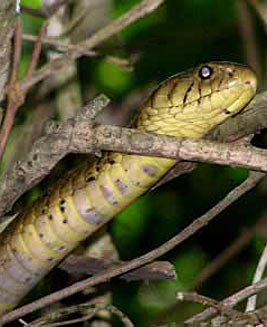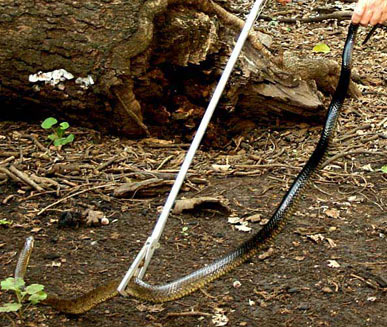|
Naja melanoleuca (Forest cobra, Black and white lipped cobra)
Boskobra [Afrikaans]
Life >
Eukaryotes
>
Opisthokonta >
Metazoa
(animals) > Bilateria > Deuterostomia >
Chordata >
Craniata > Vertebrata (vertebrates) > Gnathostomata (jawed vertebrates) >
Teleostomi (teleost fish) > Osteichthyes (bony fish) > Class:
Sarcopterygii (lobe-finned fish) > Stegocephalia (terrestrial vertebrates) >
Tetrapoda
(four-legged vertebrates) > Reptiliomorpha > Amniota >
Reptilia (reptiles) >
Romeriida > Diapsida > Lepidosauromorpha > Lepidosauria >
Squamata > Serpentes
(snakes) > Family: Elapidae > Genus:
Naja
 |
 |
|
Naja melanoleuca (Forest cobra, Black and white lipped cobra),
KwaZulu-Natal, South Africa. [photo F. Grundlingh ©,from
SARCA
Virtual Museum] |
Naja melanoleuca (Forest cobra, Black and white lipped cobra),
KwaZulu-Natal, South Africa. [photo A. Coetzer ©,from
SARCA
Virtual Museum] |
Identification
The Forest cobra can be identified the following features;
highly polished body scales, its good climbing ability, a preference for thick
vegetation in close proximity to water and its narrow hood. This snake grows to
an average length of 2 meters but can grow up to 2.7 meters in length (the
Forest cobra is the largest cobra in Africa).
Distribution and habitat
Has a very small distribution only being
found in the following areas North East KwaZulu-Natal, Southern Mozambique and on the East
Zimbabwe border. Its preferred habitat is lowland forest or costal savanna
thickets. It is common to find these snakes both in trees and small shrubs.
Food
Feeds on
amphibians (e.g.
frogs
and toads),
small
mammals (e.g.
rodents),
birds, other
snakes and fish.
Predators, parasites and disease
Fed on by other snakes.
Reproduction
Oviparous (egg laying), lays between 11 and 26 eggs in
summer.
Longevity
Like most cobra species it has an average life span of 20
years (one specimen lived for 28 years).
Medical importance
This cobra species has a highly dangerous neurotoxic venom,
It is however responsible for very few bites and there is an antivenom
available.
Links
References
-
Broadley, D.G. 1983. FitzSimons' Snakes of Southern
Africa. Delta Books, Johannesburg.
-
Marais, J. 2004. A Complete Guide to Snakes of Southern Africa.
Struik Publishing, Cape Town.
|
